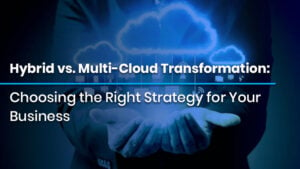
How to Strengthen Security Using CIS Controls and Posture Analysis
How to Strengthen Security Using CIS Controls and Posture Analysis Introduction In the fast-paced and ever-evolving world of cybersecurity, defending digital infrastructure goes far
Enhance your Skills in Cloud Computing , IP Networking , Microsoft , Artificial Intelligence , Cybersecurity and Many More . Come and Join IPSpecialist.

How to Strengthen Security Using CIS Controls and Posture Analysis Introduction In the fast-paced and ever-evolving world of cybersecurity, defending digital infrastructure goes far

How to Prepare for the AWS Data Engineer Exam Introduction With the world becoming increasingly data-driven, organizations are depending on cloud-based systems to store, process,

Hybrid vs. Multi-Cloud Transformation: Choosing the Right Strategy for Your Business Introduction In the digital-first economy of today, cloud transformation is no longer a
Table of Contents
In today’s digital age, cloud computing has revolutionized organizations’ operations by offering unprecedented scalability, flexibility, and cost-efficiency. However, with these advancements comes an evolving landscape of cyber threats, including the rise of supply chain attacks in the cloud. Unlike traditional cyberattacks that target an organization directly, supply chain attacks exploit vulnerabilities in the third-party vendors, software providers, or cloud services that businesses rely on. This interconnectedness of cloud ecosystems creates a complex web of dependencies, making it challenging to identify and mitigate risks effectively.
Are you ready to strengthen your organization’s defenses against cloud supply chain attacks? At IPSpecialist, we provide cutting-edge training and resources in cybersecurity, cloud security, and advanced threat mitigation techniques. Our expert-led courses are designed to empower IT professionals with the skills to navigate modern cyber threats’ complexities.
A supply chain attack occurs when threat actors compromise a third-party vendor, service provider, or software supplier to infiltrate their ultimate target. These attacks exploit organizations’ trust in suppliers, cloud service providers (CSPs), and software vendors. Instead of attacking an organization directly, attackers aim at the weakest link in its supply chain.
In cloud environments, this threat becomes even more significant. Cloud supply chain attacks focus on vulnerabilities in cloud-hosted applications, APIs, software libraries, or management platforms. Given the increasing dependency on cloud-native solutions, such attacks can lead to widespread disruptions and severe financial losses.
Here’s a typical lifecycle of a cloud supply chain attack:
Attackers research the cloud-based tools, APIs, or services the target organization relies on. This could include widely used SaaS platforms, third-party plugins, or infrastructure providers.
Threat actors infiltrate the supplier’s systems using phishing, exploiting zero-day vulnerabilities, or insider threats.
Once inside, attackers inject malicious code into the supplier’s software, cloud configurations, or APIs. This malware propagates to the target organization through updates or integrations.
The compromised software or service is often delivered to the target organization as a legitimate update. Attackers then exploit the access to exfiltrate data, disrupt operations, or deploy ransomware.
With a foothold in the victim’s cloud environment, attackers move laterally to access sensitive data, compromise other systems, or disrupt services.
The SolarWinds Orion platform was compromised with a backdoor called “SUNBURST,” affecting thousands of organizations, including Fortune 500 companies and government agencies. Although not exclusively cloud-based, many victims relied on SolarWinds for cloud monitoring, amplifying the attack’s scope.
Attackers modified Codecov’s Bash Uploader script, which exfiltrated credentials and sensitive data from customer environments, many of which were cloud-native.
Malicious actors published tampered versions of internal software libraries to public repositories like npm and PyPI. When cloud applications mistakenly pulled these libraries, attackers gained access to environments.
Kaseya’s IT management software was exploited to distribute ransomware to customers, underscoring the risks associated with SaaS platforms in cloud environments.
Cloud ecosystems rely on numerous third-party APIs, microservices, and integrations, creating multiple entry points for attackers.
Organizations often place implicit trust in their cloud vendors, overlooking software updates or integration vulnerabilities.
A single compromise can ripple across thousands of organizations due to the shared nature of cloud infrastructure.
These attacks often mimic legitimate activity, making them difficult to detect with traditional security tools.
Constantly changing cloud environments can mask attacker activity and complicate threat detection.
AI-driven security tools will play a significant role in detecting and mitigating threats in dynamic cloud environments.
Stricter regulations such as GDPR and CMMC will push organizations to adopt robust security practices.
The Software Bill of Materials (SBOM), which lists all components and dependencies, will become the standard for software transparency.
CNSPs will integrate workload protection, API security, and compliance monitoring into a unified solution.
The growing reliance on cloud technologies and third-party integrations has amplified the risks associated with supply chain attacks. These attacks exploit trust and interconnectedness, targeting the weakest links in an organization’s supply chain to compromise critical systems and data. While the challenges are significant, organizations can mitigate these risks by adopting proactive measures, such as robust vendor risk management, zero-trust architectures, advanced threat detection, and incident response planning.
A cloud supply chain attack targets third-party vendors, software providers, or service integrations that an organization relies on. Attackers exploit vulnerabilities in these suppliers to infiltrate the target’s cloud environment, often using legitimate updates or integrations as delivery mechanisms.
Organizations can use AI-powered anomaly detection tools, continuous monitoring, and behavior analytics to detect suspicious activities. Regular audits of third-party software, updates, and strict access controls can also help identify potential threats.
Zero-trust architecture minimizes the risk of lateral movement within a compromised environment by enforcing least privilege access, continuous identity verification, and strong network segmentation. It assumes no implicit trust for any user or system.
© 2025 All rights reserved | Privacy Policy | Terms and Conditions | Sitemap | Cookie Policy




